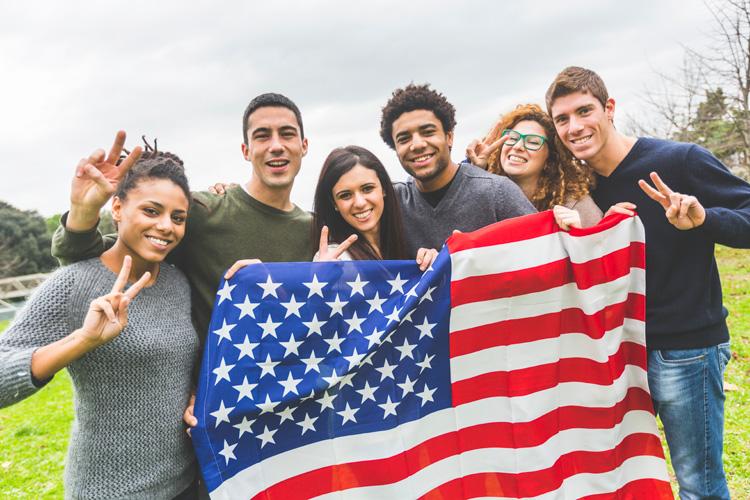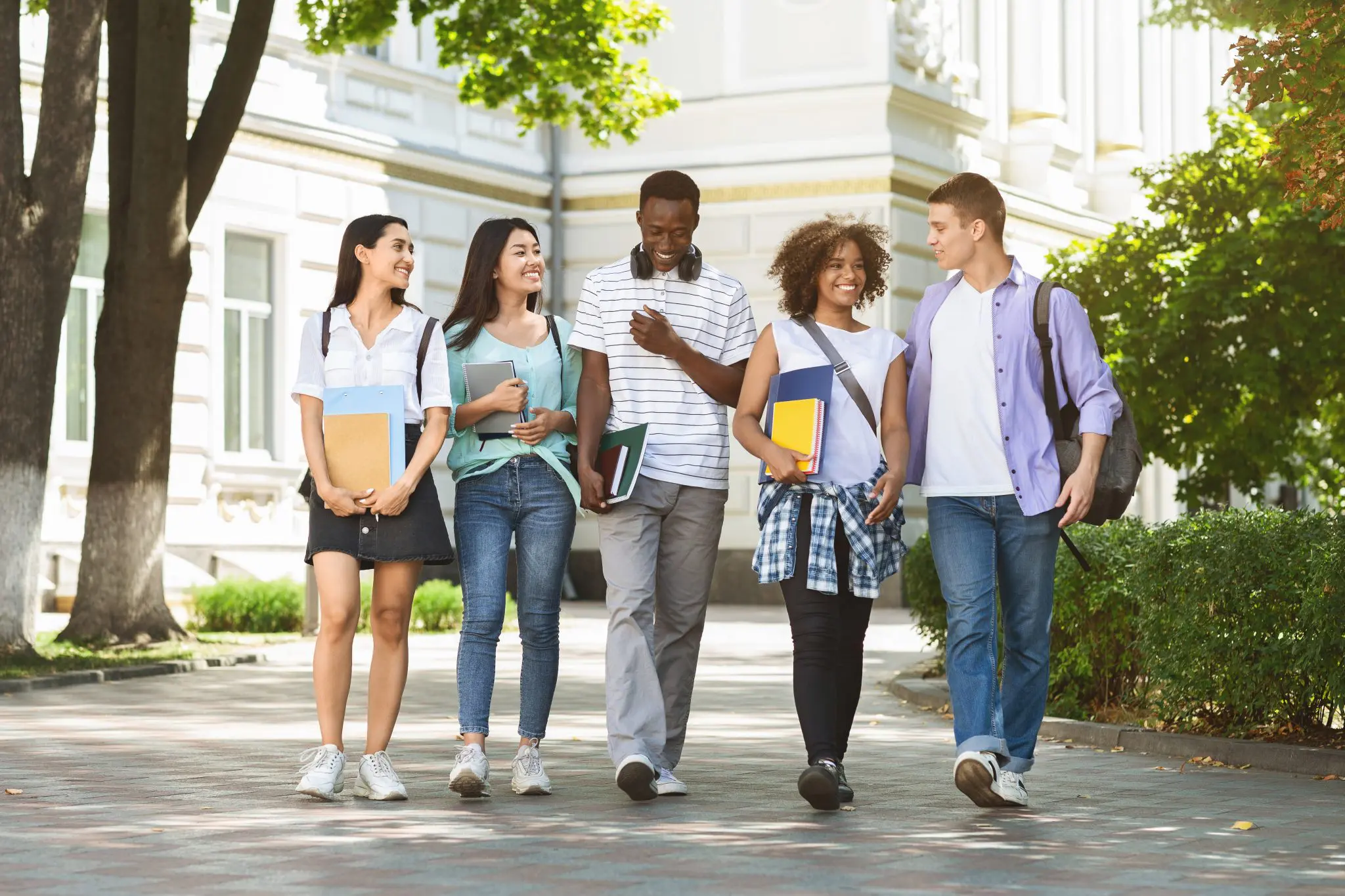
How to Apply Student Visa Online in USA?
USA Student Visa Overview
Generally, foreign nationals who wish to travel to the United States must first obtain a visa, either a nonimmigrant visa for a USA temporary stay, or an immigrant visa for permanent residence. You must have a student visa to travel to the United States to study. Your course of study and the type of school you plan to attend determine whether you need an F visa or an M visa.
You must have a student visa (F or M visa) to travel to the United States to study. You may not study after entering on a visitor (B) visa, unless you are eligible for and have obtained a change of status from USCIS, or through the Visa Waiver Program (VWP), except to undertake recreational (non-credit) study as part of a tourist visit. For more information on the VWP, see Visa Waiver Program.For short periods of recreational study, a Visitor (B) visa may be appropriate
A visitor (B) visa permits enrollment in a short recreational course of study, which is not for credit toward a degree or academic certificate. Learn more about Visitor USA Visas.Study leading to a U.S. conferred degree or certificate is not permitted on a visitor (B) visa, even if it is for a short duration. For example, a student in a distance learning program that requires a period of time on the institution’s U.S. campus must obtain a student (F or M) visa prior to entering the United States.
Student Acceptance at a SEVP Approved School
The first step to studying in the United States is apply to a SEVP-approved school in the United States. If the USA -approved school accepts your enrollment, you will be registered for the Student and Exchange Visitor Information System (SEVIS) and must pay the USA I-901 fee. The SEVP-approved school will issue you a Form I-20. After you receive the Form I-20 and register in SEVIS, you may apply at a U.S. Embassy or Consulate for a student (F or M) visa. You must present the Form I-20 to the consular USA officer when you attend your visa interview.
If your spouse and/or children will live with you in the United States while you study, they must also enroll in SEVIS, obtain individual Form I-20s from the SEVP-approved school, and apply for a visa (but they do not pay the SEVIS fee).Visit the U.S. Immigration and Customs Enforcement (ICE) Student and Exchange Visitor Program (SEVP) website to learn more about SEVIS and the SEVIS I-901 Fee.Visit the Department of State EducationUSA website to learn about educational opportunities for undergraduate and graduate study, and an overview of the application process. You can also visit the DHS Study in the States school search page to search for SEVP-certified schools.
How To Apply
There are several steps to apply for a visa. The order of these steps and how you complete them may vary by U.S. Embassy or Consulate. Please consult the instructions on the embassy or consulate website.
Complete the Online Visa Application
Online Nonimmigrant Visa Application, Form DS-160 – Learn more about completing the DS-160. You must: 1) complete the online visa application, and 2) print the application form confirmation page to bring to your interview.
Photo you will upload your photo while completing the online Form USA DS-160. Your photo must meet the Photograph Requirements.You should schedule an appointment for your visa interview at the U.S. Embassy or Consulate in the country where you live. You may schedule your interview at another U.S. Embassy or Consulate, but be aware that it may be more difficult to demostrate that you qualify for a visa outside of the USA country where you live. Wait times for USA interview appointments vary by location, season, and visa category, so you should apply for your visa early. Review the interview wait time for the location where you will apply:USA New Students – Student (F and M) visas for new students can be issued up to 365 days before the start date of a course of study. However, you will not be allowed to enter the United States on your student visa more than 30 days before the start date.Continuing Students - Student (F and M) visas for continuing students may be issued at any time, as long as the student is currently enrolled at a SEVP-approved school or institution and in USA SEVIS. Continuing students may enter the United States at any time before classes start.
Prepare for Your Interview
Fees - Pay the non-refundable visa application fee, if you are required to pay it before your USA interview. If your USA visa is approved, you may also pay a visa issuance fee, if applicable to your nationality. Fee information is provided below:
Gather and prepare the following required documents before your visa interview:
Passport valid for travel to the United States – Your USA passport must be valid for at least USA six months beyond your period of stay in the United States (unless exempt by country-specific agreements). Each individual who needs a visa must submit a separate application, including any family members listed in your passport.
Nonimmigrant Visa Application, Form DS-160 confirmation page.

Application fee payment receipt, if you are required to pay before your interview.
Photo – You will upload your photo while completing the online Form DS-160. If the photo USA upload fails, you must bring one printed photo in the format explained in the Photograph Requirements.
Certificate of Eligibility for Nonimmigrant (F-1) Student Status-For Academic and Language Students, Form I-20 or Certificate of Eligibility for Nonimmigrant (M-1) Student Status for Vocational Students, Form I-20 – Your USA school will send you a Form I-20 once they have entered your information in the SEVIS database. You and your school official must sign the Form I-20. All USA students must be registered in the Student and Exchange USA Visitor System (SEVIS). Your spouse and/or minor children, if they intend live in the United States with you, will each receive an i ndividual Form I-20. A consular officer will interview you to determine your qualifications for a USA student visa, and may request additional USA documents, such as evidence of:
ndividual Form I-20. A consular officer will interview you to determine your qualifications for a USA student visa, and may request additional USA documents, such as evidence of:
Your academic preparation, such as:
Transcripts, diplomas, degrees, or certificates from schools you attended; and
Standardized test scores required by your U.S. school;
Your intent to depart the United States upon completion of the course of study; and
How you will pay all educational, living and travel costs.
Review the instructions for how to apply for a visa on the USA website of the U.S. Embassy or Consulate where you will apply.
Attend Your Visa Interview
A consular officer will interview you to determine whether you are qualified to receive a student visa. You must establish that you meet the requirements under U.S. law to receive a visa.Ink-free, digital fingerprint scans are taken as part of the application process. They are usually taken during your interview, but this varies based on location.After your visa interview, the consular officer may determine that your application requires further administrative processing. The consular officer will inform you if this is USA required.After the visa is approved, you may need to pay a visa issuance fee (if applicable to your nationality), and make arrangements for the return of the passport and visa to you. Review the visa processing times to learn more.
Entering the United States
A visa does not guarantee entry into the United States. A visa only allows a foreign citizen to travel to a U.S. port-of-entry (generally an airport) and request permission to enter the United States. The Department of Homeland Security (DHS), U.S. Customs and Border Protection (USA ) officials at the port-of-entry have authority to permit or deny admission to the United States.After you present your passport, visa, and Form I-20 at the port-of-entry, a CBP official will make this decision. Upon admission, the USA official will provide an admission stamp or paper Form I-94, Arrival/Departure Record.Learn about procedures for students (with F or M visas) entering the United States on the CBP website under Arrival Procedures for Students or Exchange Visitors. Learn about admissions and entry requirements, restrictions about bringing food, agricultural products, and other restricted/prohibited goods, and more by reviewing the USA website.

Extending Your Stay
Foreign students in the United States with F visas must depart the United States within 60 days after the program end date listed on Form I-20, including any authorized practical training.Foreign students may request an extension through U.S. Citizenship and Immigration Services (USCIS) website (see the USCIS Extend Your Stay page). Additional information to maintain student status is on the U.S. Immigration and Customs Enforcement SEVP website under Maintaining Your Immigration Status While a USA Student or Exchange Visitor.Failure to depart the United States on time will result in being out of status. Under U.S. law, visas of individuals who are out of status are automatically voided (Section USA (g) of the Immigration and Nationality Act).Any multiple entry visa that was voided due to being out of status will not be valid for future entries into the United States.
Failure to depart the United States on time may also result in you being USA ineligible for visas in the future in certain cases. Review USA Visa Denials and Ineligibilities and Waivers: Laws to learn more.
Change of Status
If your plans change while in the United States (for example, you marry a U.S. citizen or receive an offer of employment), you may be able to request a change in your nonimmigrant status to another category through U.S. Citizenship and Immigration Services (USCIS). See Change My Nonimmigrant USA Status on the USCIS website to learn more.While you are in the United States, receiving a change of status from USCIS does not require you to apply for a new visa. However, once you depart the United States you must apply for a new visa at a U.S. Embassy or Consulate in the appropriate category for your travel.
Additional Information
There is no guarantee you will be issued a visa. Do not make final travel plans or buy tickets until you have a visa.
For information about working in the United States during your USA study, review Students and Employment and Form I-765 Work Authorization Instructions on the USCIS website.
If you have a temporary break in your study, view the information on the SEVP website under Do Students Returning from Temporary Absences Need New Visas? If your student visa is still valid, but you are outside the United States, you should consult with your USA Designated School Officials.
Spouse and children
Your spouse and unmarried, minor children who intend to reside with you during your USA study may apply for F-2 or M-2 visas. Although USA fee payment is not required, your school must issue them an individual Form I-20, which is required to apply for their visas. You must provide a copy of your F-1 or M-1 visa and provide proof of USA relationship.
Your minor children are permitted to attend school in the United States while accompanying you.
U.S. Embassies and Consulates adjudicate visa applications for same-sex spouses in the same way that we adjudicate applications for opposite sex spouses.
A valid U.S. visa in an expired passport is still valid. Unless canceled or revoked, a USA visa is valid until its expiration date. If you have a valid visa in your expired passport, do not remove it from your expired passport. You may use your valid visa in your expired USA passport along with a new valid passport for travel and admission to the United States.You've now reached Step 4! Applying for your U.S. student visa. This next step will cover F, J and M student visa types.Information pertaining to visas and travel can be found on the U.S. Department of State's Bureau of Consular Affairs website and the U.S. Department of Homeland Security's Study in the States.
Choose your level of study to learn more about applying for your student visa.
Because visa interviews are short, do your best to explain why you want to study in the United States, how you plan to support yourself while in school, and what your plans are for when your studies are finished.Effective immediately, all individuals applying for an USA F, M, or J nonimmigrant visa are requested to adjust the privacy settings on all of their social media accounts to ‘public’ to facilitate vetting necessary to establish their identity and admissibility to the United States under U.S. law.Pursuant to the Presidential Proclamation on Restricting the Entry of Foreign Nationals to Protect the United States from Foreign Terrorists and Other
National Security and USA Public Safety Threats, which takes effect at 12:01 a.m. eastern daylight time on June 9, 2025, the United States is suspending or limiting entry and visa issuance to nationals of certain countries. Applicants who are subject to this Presidential USA Proclamation may still submit visa applications and attend scheduled interviews, but they may be ineligible for visa issuance or admission to the United States.
WHAT IS A VISA?
A citizen of a foreign country who seeks to enter the United States generally must first obtain a U.S. visa, which is placed in the traveler’s passport. Visit Travel.State.gov for additional information.Certain international travelers may be eligible to travel to the United States without a visa under the Visa Waiver Program, which is administered by the Department of Homeland Security.The Visa section of this website is about U.S. visas for foreign citizens and nationals to travel to the United States.
Note: U.S. citizens do not need a U.S. visa for travel to the United States. When planning travel abroad a U.S. citizen may need a visa issued by the embassy or consulate of the country they wish to visit.
What Type of Visa Do You Need?
Short-term visits to the United States (for tourism, business, education, and more), you can go directly to the online application (form DS-160 ).
Immigrant visas, which are issued to foreign nationals who intend to live and work permanently in the United States, you can visit the U.S. citizenship and Immigration Services site for the relevant forms. If you are unsure what type of visa you need, please use the Visa Wizard below.
Form DS-5535 Supplemental Questions for Visa Applicants
If your case is under administrative processing, please follow the instructions as mentioned in the 221(g) letter you received. Please only complete Form DS-5535 Supplemental Questions for Visa Applicants if a visa officer has requested you to at the time of your visa interview. Please follow the instructions mentioned on the 221(g) letter you received and submit the form by email. Include the Word Document (2 MB or less in size), please follow closely the instructions for creating your subject line. Failure to follow instructions may result in delay of your case. Please double-check that you are sending your information to the correct email address and that you receive an autoreply after sending us an e-mail. Your visa application may be USA terminated per section 203(g) of the U.S. Immigration and Nationality Act if you do not submit the requested information within one year.
Get a student visa to study in the U.S.
To study in the U.S. as an international student, you must get a student visa. Learn about the types of USA student visas, how to apply, and if you can work while you study.
Types of student visas
F-1 and M-1 visas for full-time students
The most common student visas are F-1 and M-1. F-1 visas are for full-time international students pursuing academic studies.
M-1 visas are for full-time international students pursuing vocational studies. J-1 visa for exchange students
The J-1 exchange visitor visa is for foreign nationals who have been approved to take part in work-and-study-based exchange programs. Examples include visiting scholars, camp counselors, au pairs, and research assistants. Learn about the educational programs that J-1 visa holders can participate in.
USA Student visa requirements
Before you plan to come to the U.S. to study as an international student, get a basic overview of how the process works. Your 5 steps to U.S. study covers:
Researching USA schools
Living and educational expenses
School applications
Student visas
Preparing to come to the U.S.
International students who apply for an F-1 or M-1 visa must attend a school and enroll in courses that are certified by the Student and Exchange Visitor Program (SEVP).

Search for SEVP-certified schools in the U.S.
Learn what programs of study qualify for SEVP.
Get a more detailed overview of what immigration processes and forms are required from the time you choose a school until you complete your studies.
How to apply for, extend, or renew a student visa
Visit the Department of State’s website to learn more details about F-1 or M-1 visas and J-1 visas. Get information about:
Eligibility rules
How to apply
Appointment wait times
Application fees
Extending your stay in the U.S.
Student visa renewals
Can you work in the U.S. with a student visa?
If you have an F-1, M-1, or J-1 visa, you may be eligible to work in the U.S. But you may only qualify for work on-campus or at a job related to your studies.Learn more about employment for students with F-1 and M-1 visas.
J-1 visa holders must contact their responsible officer to find out if they qualify for work outside their program of study.As a primary step, you must first apply and be accepted by a US that is certified by the Student and Exchange Visitor Program (SEVP). Once accepted, you will receive a Form I-20 from the institution's international student office, which is a paper record of your information in the database called the Student and Exchange Visitor Information System (SEVIS).For an exchange visitor visa, you’ll have to file your application under J-1 visa, and as a pre-requisite, you have to submit DS-2019 form that will be given by your sponsoring US institution.
Documents required for a US student visa
When applying for your student visa for the US, you will generally need: A valid passport that is valid for at least six months beyond your period of stay in the US (unless exempt by country-specific agreements) Acceptance at a SEVP approved school and your Form I-20 Application fee payment for the SEVIS Non-immigrant visa application and the Form DS-160 confirmation page Your photograph in the requested format, and number If you are opting for Optional Practical Training (OPT), then in addition to the Form I-20, you must apply to USCIS for an Employment Authorization Document (EAD) Some additional documents that might be required include: Academic preparation documents such as transcripts, diplomas, degrees or certificates Evidence that you have sufficient funds to maintain your living expenses throughout the period of your stay in the US. This may include:
Bank statements
USA Financial undertaking by a sponsor to cover your accommodation and living costs A scholarship program Evidence that you will leave the US once you have completed your course of study. This can be in the form of an air ticket out of the US to your home country You may also have to appear for a personal interview at the US embassy or consulate. *Please note that these are the basic requirements, speak with your IDP counsellor for a detailed list of documents required for visa processing
Applying for your visa online
You’ll have to apply for your student visa application online using the US Embassy Sri Lanka website. Remember, your application date is the date when your application fee is paid.
How can IDP help with your visa application?
If you’re an IDP USA student with an offer letter from any of our partner institutions in the US, we can advise you on how to go about the entire process. We’ll make sure you are fully informed on the latest visa requirements and USA conditions; also help you prepare the right documents for your submission.
Our team of experts will direct you to the official USA websites and to authorised USA immigration USA representatives to ensure you have the latest applications forms and USA guidance. To reduce the hassle, we can also help to certify, translate and courier your documents.
Visa fee
As an applicant from outside the US, you will have to pay US$160 as an application USA visa fee (do check the latest fee when applying here.)There is now a USA US$350 SEVIS fee on F and M USA visa applications and US$220 on most of the J Visa applications, this includes the cost of the computer USA system which is used to record your stay in the United States (SEVIS).
English language requirements
To gain your US student visa, you’ll have to provide USA evidence of proficiency in the English language. This usually means passing a secure English language test to be able to prove your communication and correspondence skills.The USA International English Language Testing System (USA IELTS) is the world’s most popular high-stakes English language proficiency test for study, work and migration, with more than three million tests taken in the past year. The IELTS results are recognised by more than 10,000 organisations, including USA educational institutions, employers, professional associations and governments, in 140 countries around the world.
US educational institutions require a minimum IELTS score of 6.5 bands.
When you first arrive in the US, you must:
Contact your designated school official on a priority basis Contact your designated school official again, no later than the program start date listed on your Form I-20 Making sure your visa remains valid
Once you get your visa, there are several things you need to do to ensure it remains valid, including: Fulfilling the purpose for why the USA Department of State issued the USA visa Following the regulations associated with that purpose
While studying in the US, you will need to observe the following rules:
You must attend and pass all of your classes. If you are finding your studies too difficult, you should speak with your designated USA school official (DSO) immediately If you think you will be unable to complete your program by the end date listed on your Form I-20, you must talk to your DSO about requesting a possible program extension You must take a full course of study each term. If you cannot study full-time, contact your DSO immediately You cannot drop below a full course of study without consulting with your DSO You can always contact us for a free counselling session and we can guide you on how to go about the entire visa application process.
Posted on 2025/07/12 09:30 PM
